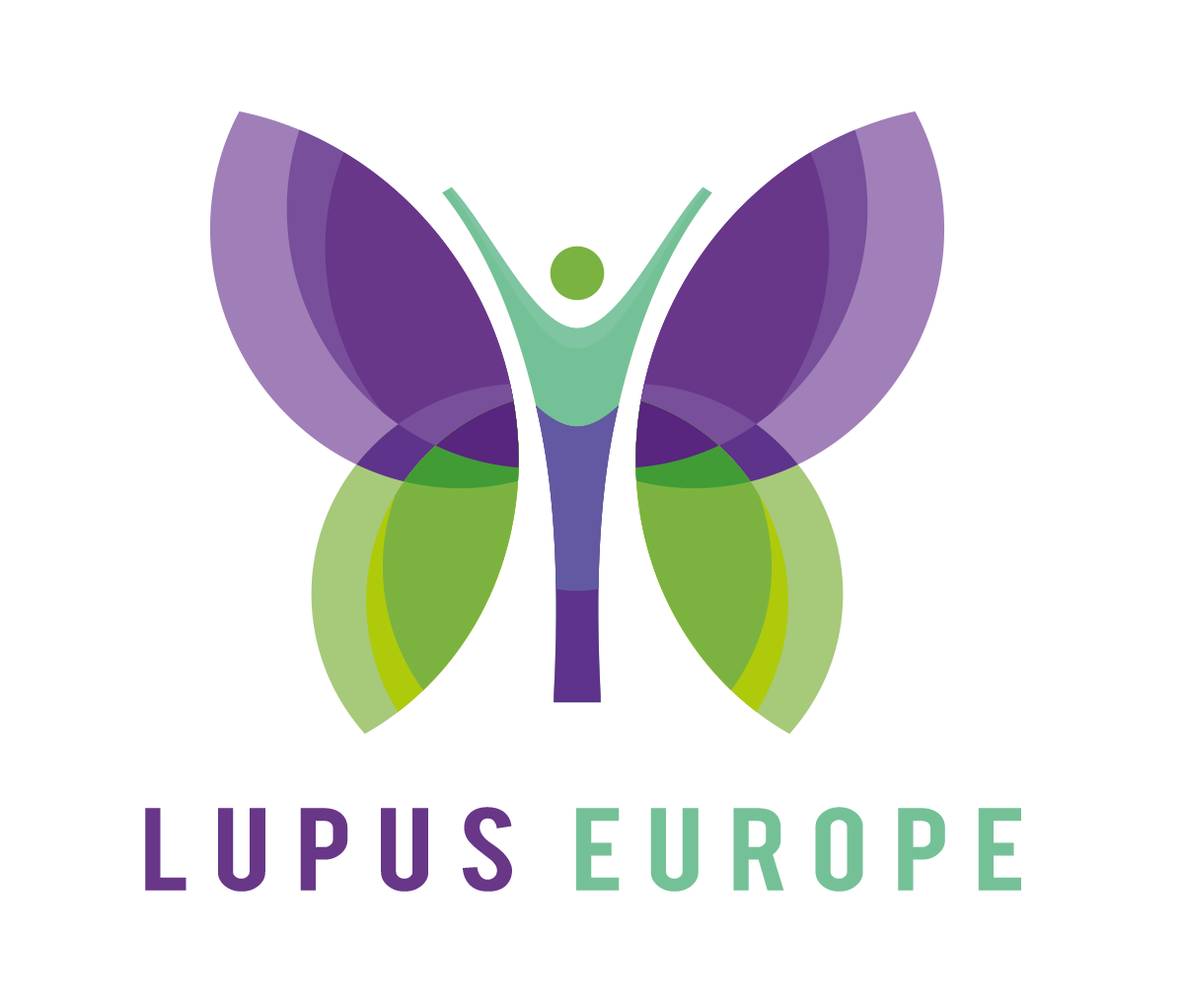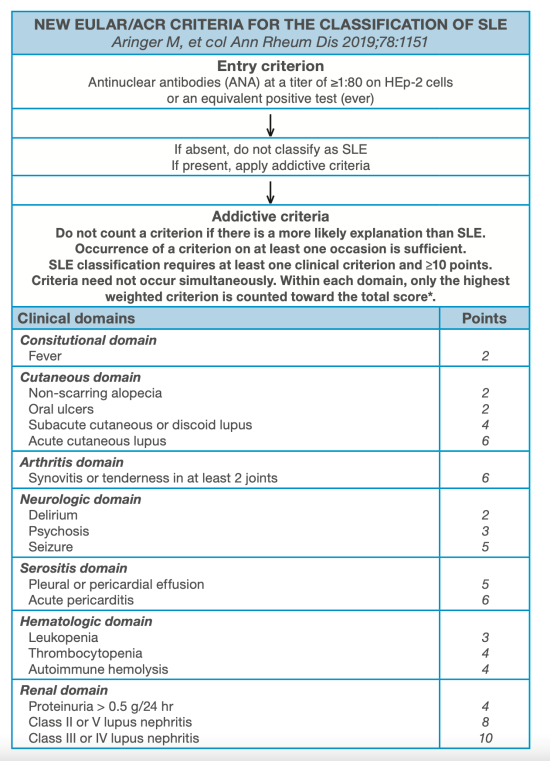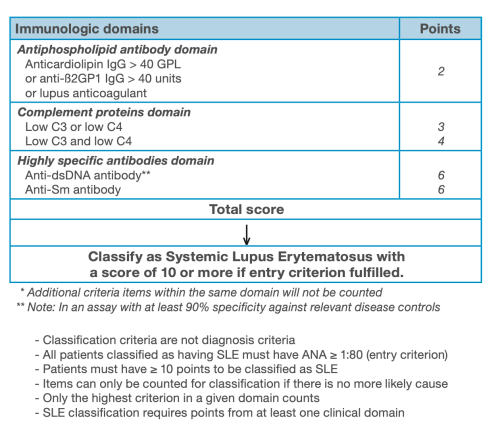Annexes

Browse the content

Appendix 1 - Criteria for Systemic Lupus Activity
SLEDAI or (Systemic Lupus Erythematosus Disease Activity Index) gives an idea of the activity of systemic lupus. The weight assigned to each variable was determined by statistical analysis on cohorts of patients with systemic lupus. The events described are taken into account if they are present on the day of the consultation or in the previous 10 days.
This SLEDAI-2K activity index was introduced 20 years ago. This score combines clinical and biological criteria.
Appendix 2 - CLASSIFICATION CRITERIA FOR SLE (systemic lupus erythematosus)


Appendix 3 - Lupus drugs
Alphabetical order of the INN (International non-proprietary name). The indicated dosages correspond to the adult treatment.
Main indications in lupus
As an add-on therapy for the treatment of adult patients with moderate to severe, active autoantibody-positive systemic lupus erythematosus (SLE), despite receiving standard therapy.
Main indications in lupus
- Severe forms of lupus, in patients who are intolerant to steroids or steroid-dependent or whose therapeutic response is insufficient despite treatment using high doses of steroids
- Associated autoimmune hepatitis
- Some autoimmune cytopenias (decreased quantity of blood cells in the bloodstream)
Main indications in lupus
In combination with usual treatment, in adult patients or children older than 5 years with active systemic lupus, presence of autoantibodies and high disease activity (defined for example by the presence of native anti-DNA antibodies and a low complement) despite standard treatment. It can also be used to treat adults with active lupus nephritis who are receiving standard therapy.
Not indicated in neurological lupus impairment.
Main indication in lupus
- Any lupus patient (cutaneous-articular and / or visceral lupus) should be put, in principle, on synthetic antimalarials (hydroxychloroquine or chloroquine) unless contraindicated.
- Chloroquine is usually given as a second line of treatment, in case of failure or intolerance to hydroxychloroquine. These drugs belong to the group of synthetic antimalarials.
Main indications in lupus
Severe forms of lupus, especially with renal or central nervous system involvement
Main indication in lupus
- Any lupus patient (cutaneous-articular and / or visceral lupus) should be put, in principle, under Hydroxychloroquine unless contraindicated.
- Hydroxychloroquine has a particular effectiveness on the different forms of cutaneous lupus, but it also reduces the risk of visceral involvement (renal damage in particular) and reduces the risk of sequelae related to the disease. It is associated with longer survival.
Main indication in lupus
Methotrexate does not have market authorisation for lupus, but experts recognize an effectiveness in lupus with severe joint / cutaneous involvement or with serous involvement (pleuritis, pericarditis).
Main indications in lupus
Mycophenolate Mofetil (MMF) does not have a marketing authorization for lupus, but experts recognize efficacy in severe lupus, especially in cases of severe renal or visceral damage.
Main indications in lupus
Mycophenolate Sodium does not have a marketing authorization in lupus, but experts recognize efficacy in severe lupus, especially in cases of severe renal or visceral involvement.
Main indications in lupus
Lupus with joint involvement or visceral involvement (kidney, pleura, pericardium ...)
Main indications in lupus
Lupus with joint involvement or visceral involvement (kidney, pleura, pericardium ...).
Main indications in lupus
Rituximab does not have a Market authorisation for lupus, but experts recognize potential effectiveness in severe lupus, especially in cases of severe haematological, renal or visceral involvement.
Tacrolimus (a calcineurin inhibitor) has no approval in systemic lupus, but some experts recognize its effectiveness in lupus with renal involvement, particularly in combination with Mycophenolate Mofétil.
Voclosporin (a calcineurin inhibitor) is approved in combination with a background immunosuppressive therapy regimen for the treatment of adult patients with active lupus nephritis. Dosage is not based on patient's body weight. The blood trough concentration should not be monitored.
Appendix 4 - Lupus Drugs & Pregnancy and Breastfeeding
- Low-dose aspirin (100 mg/day)
- Hydroxychloroquine
- Azathioprine
- Corticosteroids
- Low molecular weight heparins
- Ciclosporin
- Tacrolimus
NSAIDs: chronic use of all NSAIDs (including acetylsalicylic acid ≥ 500 mg/d and COX-2 inhibitors) is not recommended during pregnancy and is formally contraindicated from 24 weeks of amenorrhea.
Breastfeeding is most often possible for the following drugs, but it is appropriate to check with your doctor beforehand.
Appendix 5 - The list of HCPs in Europe
The list is available on the website:
ERN Reconnect: www. reconnet.ern-net.eu
Appendix 6 - Lexicon
The main protein in the blood, albumin constitutes 50 to 65% of the proteins in the blood plasma (liquid part of the blood). Soluble in water and made by the liver, it is not part of the globulins which are the other proteins in the blood. Its level, called albuminemia, is about 40 grams per litre of blood. Albumin is also found in egg (ovalbumin) and milk (lactalbumin).
The term proteinuria refers to the abnormal presence of proteins, of any kind, in the urine. Albuminuria corresponds, more specifically, to the abnormal presence in the urine of a particular variety of protein: albumin.
Alopecia is a loss of hair on all or part of the scalp. To be distinguished from baldness which is the absence of hair.
Antibodies, also called immunoglobulins, are blood proteins synthesized by certain cells of the immune system (B lymphocytes and plasma cells) in response to the intrusion of a foreign body (antigen) into the body.
Anticoagulants are molecules intended to delay or prevent clotting. They make the blood more fluid and can cause bleeding.
An antigen is a substance foreign to our body (which it does not usually possess) that causes an immune reaction with an antibody.
Antimalarials are drugs used in the curative or preventive treatment of malaria. Some antimalarials also express immunomodulatory properties that are used in the treatment of autoimmune diseases.
Arthralgia is a pain located in the joints without any external visible change in the joint. The pain increases when the patient mobilizes the joint(s) concerned.
This name is given to acute or chronic inflammatory conditions that affect the joints and are accompanied by swelling of the synovial membrane.
Atheromatosis is a disease of the vessel wall, partly caused by abnormalities of fats (hypercholesterolemia, hypertriglyceridemia)..
These are antibodies produced by the body during autoimmune reactions during which the patient fights abnormally against his own immune defences.
A biopsy is a medical examination that involves removing a portion of tissue from an organ, so that it can be studied. Its main interest is to give objective results in certain diseases that require a definite diagnosis.
Biotherapies refer to a new generation of medicines. On the model of natural biological molecules, they are similar or identical to proteins produced by the body (enzymes, proteins, antibodies).
The blood count is the result of the quantitative and qualitative study of the elements of the blood, that is, red blood cells, white blood cells and platelets.
A chromosome (from the Greek khroma : color and soma : body, element) is a structure made up of DNA surrounded by proteins.
Coagulation is a process of transforming liquid blood into a semi-solid gel. It causes the formation of a clot and allows the cessation of bleeding following an injury.
Drug of the immunosuppressant family (see immunosuppressant)
Cytokines are small proteins that act on cells of various types with receptors of their own for each of them. Secreted by lymphocytes (white blood cells involved in cellular immunity) and macrophages (defence cells responsible for digesting foreign particles)...
Cytopenia is a term that generally defines the progressive decrease of cell lines.
Dialysis (from the Greek dia : through, and luein : dissolve) is also called extrarenal purification and is most often practiced with an artificial kidney.
Dyslipemia (from the Greek due : difficulty, lipos : fat, and haima: blood) is an anomaly (often on the excessive side) of cholesterol and triglycerides.
Echography is an examination method that uses ultrasound and allows the visualisation of certain parts of the body that are usually hidden from view.
The electrocardiogram records the electrical functioning of the heart during its relaxation-contraction cycle. Since the heart is a muscle, it needs electrical stimulation to contract.
An electromyogram is a device that measures the electrical activity of nerves and muscles. It collects electrical activity through micro-electrodes in the muscle or taped to the skin.
An enzyme is a biological catalyst, that is, a molecule that accelerates the chemical reactions of metabolism taking place in the cellular or extracellular environment up to millions of times.
Fibromyalgia is a complex disease, characterised by the existence of diffuse and multiple pains, and of certain points on the body which are painful when pressed.
Haematuria is the presence of blood in the urine. Haematuria can be macroscopic (i.e. it is visible), and the urine is then coloured in red, pink or brown and sometimes contains blood clots.
Haemolysis is the normal or pathological destruction of red blood cells. This destruction is the result of multiple processes, including autoimmune haemolysis.
Headaches are head pains, regardless of their cause. Commonly called "headaches", they are located on the cranial vault, excluding the neck and face. Very frequent, they are one of the first reasons for medical consultation.
Hypergammaglobulinemia is the increase in serum gamma globulin concentration above 18 g/l. This increase is found during various inflammatory syndromes or during malignant plasma cell proliferations.
Hypocomplementemia is a deficiency of complement protein in the body.
Hypoglycaemia is the decrease in the amount of glucose (sugar in general) below 0.5 g / l, contained in the blood. Glucose is the main energy substance that can be lacking in the brain.
Immunogenetics is the study of genetic factors involved in the mechanisms of immunity.
The term immunosuppressant (or immunocompromised) refers to anything that suppresses or has the ability to reduce the body's specific immunological reactions against an antigen (foreign body entering the body).
Interferons are part of cytokines, small proteins secreted by different types of cells involved in immunity, which have a regulatory and stimulating action of the immune system.
Leukocyturia is the presence of leukocytes, or white blood cells, in the urine. Normally, only a few white blood cells are eliminated through the urine.
Lymphadenopathy corresponds to a swelling of a lymph node, adenomegaly, of inflammatory, infectious or tumoral origin. Superficial lymphadenopathy (neck, armpit, groin) is detectable by simple clinical examination.
Lymphocytes, a variety of white blood cells, are involved in the immune response. They are of two kinds: B lymphocytes (production of antibodies) and T lymphocytes (cell-mediated immunity).
The term lymphopenia refers to the decrease in the number of lymphocytes.
The macrophage is a variety of white blood cell, large in size, having the property of absorbing and destroying large particles such as a damaged or aged cell...
Malaria is an infectious disease caused by parasites injected into humans by certain mosquitoes. This tropical condition, widespread in the intertropical zone, is a serious disease that can be fatal if proper care is not provided.
Lumbar puncture is an act of introducing a hollow needle, at the lower part of the spine, into the medullary canal.
MRI uses the magnetic energy of protons to study with great precision many organs such as the brain, spine, joints and soft tissues.
Myalgia is muscle pain. They are also found in various diseases, acute or chronic, of mechanical, inflammatory, chemical, infectious or autoimmune origin.
The myelogram is a study of the marrow that is extracted under local anaesthesia. It consists in analysing the morphology and equilibrium of the different cells present in the bone marrow.
Myositis is the inflammation of striated muscle tissue that leads to pain and decreased muscle strength, and an increase in blood levels of enzymes from the muscles (creatine kinase).
Neutropenia is a blood disorder that occurs when the number of neutrophils, one of the types of white blood cells found in the blood, is abnormally low.
Neutrophils are polynuclear neutrophils, a category of white blood cells capable of fighting bacterial infections.
Nonsteroidal anti-inflammatory drugs, often abbreviated as "NSAIDs", are drugs with anti-inflammatory, as well as analgesic and antipyretic properties, that is, they reduce inflammation, pain and fever.
Pericarditis (from the Greek peri: around, cardia: heart, and desinence – ite: inflammation) refers to an inflammation that affects the layers that surround the heart, the pericardium.
Phlebitis is defined as the formation of a blood clot (thrombosis) in a vein, which is responsible for obstructing blood flow in that vein.
Photosensitivity reflects the excessive sensitivity of the skin to solar radiation, especially ultraviolet radiation, resulting in a rash. Photosensitivity may be secondary to the ingestion or application to the skin of a chemical or drug product.
The placebo effect is the effect that can be observed by taking a treatment that does not contain any active ingredients. This placebo effect...
A platelet (or thrombocyte) is a figurative element of blood that is formed in the bone marrow and fragments into small elements.
Pleurisy (from the Greek pleuron : side) is the inflammation of the membrane that covers and protects the lungs, the pleura...
The polynuclear cell is an essential cell of our body because it is responsible for the elimination of pathogens, such as bacteria, after they have been recognised by the immune system.
The term proteinuria refers to the abnormal presence of proteins, of any kind, in the urine.
The abnormal cut-off commonly used is 0.3g/g of creatinine or 0.3g per 24 hours.
Remission is the strong attenuation of, or disappearance of, temporary symptoms of a disease.
A distinction is made between basic research protocols, which aim to improve understanding of the pathophysiology of the disease, and clinical and therapeutic research protocols...
Appendix 7 - LUPUS EUROPE
LUPUS EUROPE is the European umbrella organisation that brings together national lupus patient organisations from across Europe. It is a non-profit independent organisation, aiming to support and empower national member organisations, sharing information with them and promoting better patient-centred processes, both within the healthcare field and at a political level.
Since its humble beginnings in 1989, LUPUS EUROPE has grown to represent most of Europe’s main countries which, in turn, represent over 30,000 patients in their respective memberships. It is now considered a valued partner at medical conferences, in European healthcare organisations fighting for wider patients’ rights, and in Europe-wide initiatives aimed at improving healthcare and setting “standards of care” for lupus patients. LUPUS EUROPE is recognized by the EMA (European Medicines Agency) and regularly invited to provide patient views on new treatment related questions. It is important for our community that we not only act at national level, but also bring the patient voices all the way to cross border care bodies and initiatives.
LUPUS EUROPE’s vision is “A fulfilling life for all people with lupus in Europe, until we have reached a world without lupus”. This vision directs its key strategies: (a) that people with lupus participate in, and benefit from, lupus Research; (b) that member organisations are enthusiastic and empowered, and (c) that Lupus Europe is heard and active in key projects. These 3 strategic goals are themselves divided into a number of projects pursued by LUPUS EUROPE, its members and volunteers.
LUPUS EUROPE is a volunteer-based organisation. It is led by a 7-person strong volunteer Board of Directors, all living with lupus themselves or closely related to a person living with lupus. A small secretariat – itself also having direct experience of the disease – supports the Board, and a network of around 40 volunteers is engaged on multiple projects carefully selected to support our vision and key strategic objectives.
For more information about LUPUS EUROPE, visit www.lupus-europe.org
If you are interested in volunteering for LUPUS EUROPE, contact se*********@**********pe.org
To find a Lupus patient group, member of LUPUS EUROPE, see below:
Our members’ network
- Europe: www.lupus-europe.org
- Belgium (Flemish): www.cibliga.be
- Belgium (French): www.lupus-belgium.org
- Bulgaria: www.revmatologia.org
- Croatia: www.facebook.com/UdrugaCrveniLeptir
- Cyprus: www.rheumatism.org.cy
- Denmark: www.sle.dk
- Estonia: www.facebook.com/luupuseselts
- Finland: www.sle-yhdistys.fi
- France: www.lupusfrance.com
- France: www.lupusplus.com
- Germany: www.lupus.rheumanet.org
- Greece: www.arthritis.org.gr
- Hungary: www.lupusz.hu
- Iceland: www.gigt.is
- Israel: www.inbar.org.il
- Italy: www.lupus-italy.org
- Lithuania: www.facebook.com/groups/1570938559829856
- Netherlands: www.nvle.org
- Norway: www.sle.no
- Poland: www.3majmysierazem.pl
- Portugal: www.lupus.pt
- Russia: www.revmo-nadegda.ru
- Slovakia: www.klubmotylik.sk
- Slovenia: www.revmatiki.si
- Spain: www.felupus.org
- Sweden: www.reumatikerforbundet.org
- Switzerland: www.lupus-suisse.ch
- United Kingdom: www.lupusuk.org.uk
